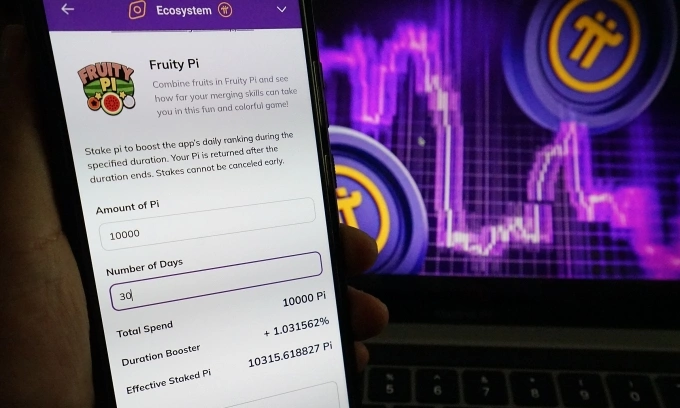
On June 28 Pi Network introduced two new features during Pi2Day: Pi app studio, which allows users to create and run apps “using human language, without needing a technical background,” and ecosystem directory staking, which is designed to “actively support and promote the ranking of Pi apps and utilities” within the ecosystem.
“With ecosystem directory staking, users can ‘place trust’ in an app they like by staking Pi tokens, either daily, monthly or yearly, to raise its rank and attract more attention,” Hoang Anh, an administrator of a Pi Network Facebook group, explained. “However, this does not mean users will earn any profits as some mistakenly believed.”
Many users admitted to misunderstanding the feature after being influenced by key opinion leaders within the Pi community. Articles promoting “staking Pi for profit” were widely circulated and gained a lot of attention, he said.
The Ecosystem Directory Staking feature on Pi Network mobile app. Photo by VnExpress/Duy Phong
Minh Thuan, a Pi investor in HCMC, said: “I thought staking would help me earn Pi, so I staked 3,000 Pi in an app called Maps of Pi for a year. Now, I can’t withdraw them for transactions and don’t know how to cancel.”
Anh Vu, a member of the Pi-focused Facebook group with over 200,000 members, said: “Many KOLs promoted ecosystem directory staking when it launched, showing off how they had staked tens of thousands of Pi tokens. I followed suit, but now I’m left watching my tokens being locked with no way to access them.”
In the comments section, many users echoed similar frustrations, expressing regret for following others without fully understanding the feature. Some, more cautious, had tested staking for a day and successfully withdrew their Pi though without any interest.
Staking typically involves locking a set number of tokens in a blockchain to earn rewards based on the amount staked and the commitment period. However, unlike farming (which also locks tokens to earn rewards), tokens staked on Pi Network are used for validating transactions on the blockchain.
After the staking period ends, users typically receive their original tokens along with additional tokens as rewards. “This misunderstanding led many users to assume Pi’s staking worked similarly, and so they staked their entire Pi holdings for long periods instead of starting small or reviewing the terms carefully,” Anh said.
In a blog update on June 30, the project’s Pi Core Team (PCT) clarified: “Note there are no Pi rewards on the protocol level for the staking as it does not make sense for the network to promote one Pi app over another through this staking feature.
“It is up to the third-party developer of a specific Pi app or service if they want to provide any incentive, whether that be in the form of app features and quality, user experience, in-app rewards, promotions etc, to pioneers to stake Pi for their app or service and increase their ranking in the ecosystem.
“The original staked amount will be returned to the users once the staked duration has ended.”
Following the clarification, PCT suspended the staking feature. However, many users on social media complained that they had not yet received their staked Pi tokens and were left feeling helpless.
Pi Network’s Pi Day (March 14) and Pi2Day (June 28) are major events for the community, with the Pi Core Team often making important announcements or launching updates. Crypto site CCN noted that this year’s Pi2Day saw no meaningful progress, with the team still struggling to move forward with existing features.
The project had previously faced criticism for “frustrating users” with slow progress on promised ecosystem improvements.
The market reacted poorly to the changes. Pi’s token price, which stood at US$0.66 on June 26, has since dropped to $0.50. Pi Network has 60 million members in 200 countries and territories, the same as a year ago.
Launched in 2019 Pi Network promoted itself as a way for users to mine the crypto for free by tapping a button in its mobile app daily. Vietnam is among the countries with the most miners. The project has been controversial, taking nearly six years to launch its mainnet before finally allowing users to transfer Pi to exchanges for trading on Feb. 20 this year.
But the project is still viewed as an incomplete blockchain initiative, lacking smart contract functionality and open-source transparency. To date the development team has only introduced limited updates, including a domain name auction feature, the PiFest shopping campaign and a few small-scale applications.
Subsidiary of VnExpress
License number: 71/GP-CBC, Ministry of Information and
Communications, September 22, 2021
Editor-in-Chief: Pham Van Hieu
Email: evne@vnexpress.netTel: 028 7300 9999 – Ext 8556
10th floor, Block A FPT Tower, 10 Pham Van Bach, Cau Giay Ward, Hanoi
© Copyright 1997 VnExpress.net. All rights reserved.
